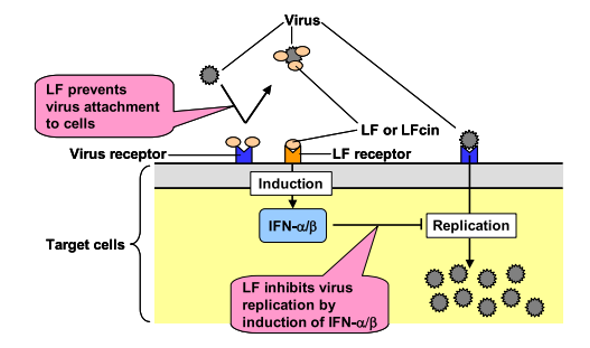Lactoferrin and common colds
Lactoferrin
Duration: 4 minutes

Lactoferrin and common colds
Respiratory tract infections (RTIs) contribute to a significant global burden of morbidity and mortality, ranking among the top 10 leading causes of death worldwide and a major cause of mortality in children under five years old {1}. Supporting the immune system is therefore especially crucial during the cold and flu season.
In recent years, multiple studies have shown the positive effects of lactoferrin (Lf) on common infections like the common cold, flu, and RTIs. Lf plays a vital role in innate defense against pathogens and may be essential in supporting the immune system and helping prevent colds {1-4}.
A meta-analysis of six randomized controlled trials, involving a total of 1,994 participants, tested the hypothesis that Lf administration is associated with a reduced risk of RTIs across age groups. Results showed significantly lower odds of developing RTIs, shorter disease duration, and milder symptoms among participants receiving Lf compared to a control group. This study supports Lf’s effectiveness against RTIs at a substantial sample size {1}.
Another meta-analysis of 25 studies concluded that a daily intake of 200 mg of Lf significantly reduced inflammatory markers, boosted immune cell activity, and decreased the occurrence and severity of RTIs. For children and infants, Lf intake was shown to lower RTI incidence, reduce typical symptoms like cough, wheezing, and rhinitis, and shorten illness duration, indicating improved immune function {2}.
Several recent trials have focused specifically on evaluating Lf's effectiveness in maintaining respiratory health. In a randomized, double-blind, placebo-controlled trial conducted at Kyushu University of Health and Welfare in Japan, 145 healthy adults ingested either a placebo (77 participants) or 200 mg/day of bovine Lf (68 participants) for 12 weeks. The main factors for evaluating Lf’s effectiveness included total respiratory and systemic symptom scores and plasmacytoid dendritic cell (pDC) activity, a critical component in the antiviral immune response. The Lf group showed significantly lower respiratory symptom scores and increased pDC activity compared to the placebo group after 12 weeks. These findings suggest that orally ingested Lf supports immune function by enhancing pDC activity and helps maintain respiratory and systemic health in healthy adults {3}.
Another randomized controlled trial evaluated the effects of Lf on preschool children with recurrent respiratory infections. A sample of 50 children, aged 4.2 ± 0.1 years, was randomly divided into two groups: Lf and placebo. Results showed that during the 4-month active phase, children in the bLf group experienced fewer respiratory infection episodes (RIEs), shorter symptom duration, and reduced need for medication compared to the control group {4}.
Antiviral

Lactoferrin has shown strong antiviral activity against both enveloped and naked viruses across various studies [5,6]. These studies report similar antiviral effects for both iron-saturated and iron-unsaturated forms of Lf. Lf exhibits a direct antiviral effect by preventing virus entry into host cells, either by blocking cellular receptors or directly binding to viral particles (blocking viral receptors) [5]. Notably, bovine Lf has been reported to have higher antiviral activity than human Lf [6]. Lf’s ability to bind to both host cells and viral particles emphasizes its role as a significant protective barrier against viral attacks.
- direct antiviral effect of Lf:
- blocking viral receptors such as heparan sulphate proteoglycans by Lf binding to these receptors and blocking the "entrance" into the host cell {1-4}
- the reduction of viral replication by inducing type I IFN production {1-3}
- indirect antiviral effect by influencing immune cells (see below). {2}
- In addition, significant antiviral potential against influenza A virus was confirmed in vitro. Lf was shown to suppress influenza A virus-induced apoptosis, haemagglutination, i.e. the clumping of erythrocytes, and subsequent infectivity. {1,5}
The antiviral activity of Lf was also discussed in more detail in our first news article: Mercurius Production (mercurius-production.com)
Immunomodulatory
As a natural component of the innate immune system, Lf can support both this and the adaptive immune system by activating important immune cells such as dendritic cells and leukocytes.
Especially in older people from the age of 40, it was shown that Lf can increase the activity of natural killer cells, i.e. innate immunity. Natural killer cells belong to the lymphocytes, which have a cytotoxic effect, i.e. they can destroy harmful cells.{2}
The presence of Lf receptors on a range of immune cells confirms a multifaceted role of Lf in modulating the immune system, both innate and adaptive.{1-3}
Antibacterial
- Lf can breach the bacterial cell membrane by binding and sequestering the lipopolysaccharide (LPS) found in the cell membrane of Gram-negative bacteria Preventing the initiation of the LPS-mediated proinflammatory cascade and the resulting cell damage by inhibiting bacterial adhesion and entry into the host cell {1,2,6}
- Inhibition of bacterial growth through the direct binding of iron (iron promotes bacterial growth) "Starvation" of pathogenic bacteria {1,2}
Overall, the administration of Lf to RTIs has already shown promising, sometimes significant efficacy in different age groups. {1,2}
The authors Ali et al. also conclude from the results of their metaanalysis that current evidence supports fortifying infant formula with Lf. {1}
In adults, the results also suggest that Lf can play a positive role in the treatment of symptoms and recovery of patients suffering from RTIs. {1,2}
However, this still requires further research for evidence.